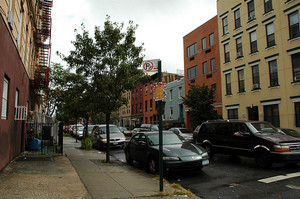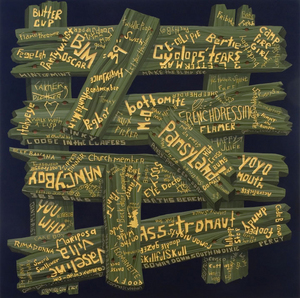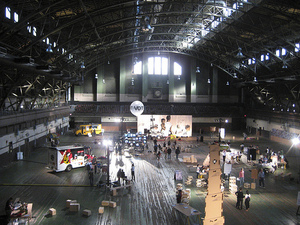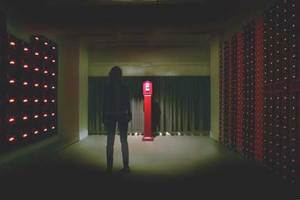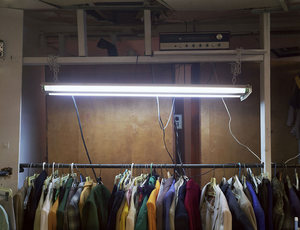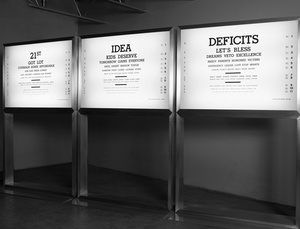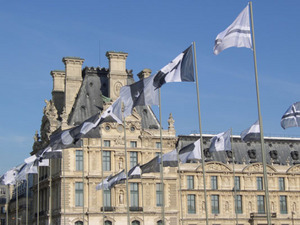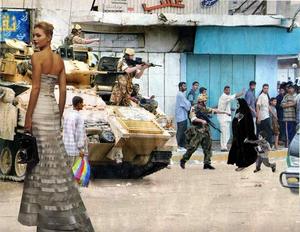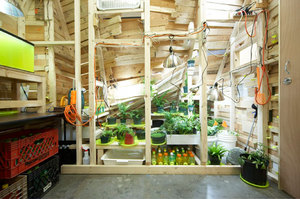This is an archive of the ArtCat Zine, 2007-2009. Please visit our new project, IDIOM.
September 2008
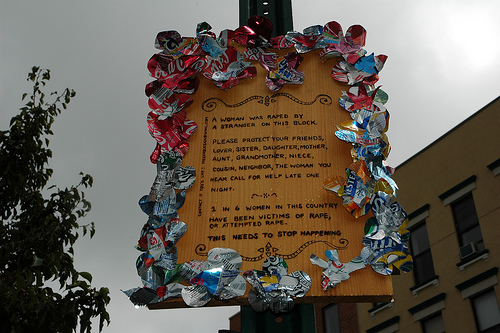
At a nondescript corner of Meserole and Humboldt in the eastern section of Williamsburg stands an unusual and what seemed to me consciously-folksy sign bolted to a no parking sign. It reads:
"A woman was raped by a stranger on this block. Please protect your friends, lover, sister, daughter, mother, grandmother, niece, cousin, neighbor, the woman you hear call for help late one night. 1 in 6 women in this country have been victims of rape or attempted rape. This needs to stop happening."
Framing the message, which is burned into a flat piece of wood, is a dense border of flowers made out of aluminum cans. Also on the work is an email address and a shy invitation to reach out to the sign's creator.
I wrote the individual to learn more about this work, a strange meeting of micro-monument, public service announcement and folk art. I received a response from the sign's maker the next day and she agreed to speak to me over email but not in person because she explained: "My case is still in court and i don't want to jeopardize my anonymity."
The circumstances of the crime that was committed against her is chilling. She told me that one day on her way home at 2am she was assaulted as she opened her front door. Forced inside, she was held in her apartment for five hours, raped and robbed her assailants let her go the next morning. Follwing is record of our conversation about the art work that aims to raise awareness about the crime of rape and its impact on a community.
Hrag Vartanian: Who are you? Are you an artist?
Anonymous: I am a 26 year old female living in Brooklyn, where I've lived for the past 4 years. I've been in NYC for 8 years now. I came to New York for art school, and have been developing my studio practice since I graduated 4 years ago. I am a sculptor and installation artist.
HV: Do you consider the sign in north Brooklyn a work of street art?
A: I've honestly never made street art before. I admire a lot of street artists but I have never felt that my own work needed or wanted to be in the streets. It's never been part of the dialogue in my work. I suppose the sign is a piece of street art because it's purpose is to directly communicate with the community, and it's about the community. It needs the context of the street to be successful. I don't think it could exist in the same way in the gallery.
HV: Why did you create it?
A: I had heard about and seen the Ghost Bikes installed around the city, and was really inspired by their idea to memorialize a tragedy with street sculpture. You probably know about them: a broken bike is spray painted-white and chained to a street sign near the location of a cyclist's death. So, I thought of making a sign to create awareness of rape occurrences, to make people realize that it can, and has, happened in their neighbor, or to their neighbors.
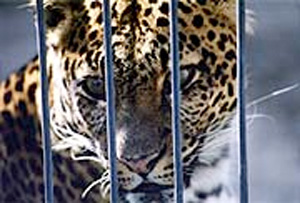
Conversations on the Contemporary: Artists and the Election
6:30 - 8:30 Wednesday 1 October 2008
Art in General - 79 Walker St, New York NY
This Wednesday at Art in General, artist Mary Billyou moderates a discussion on the significance of the upcoming presidential election between filmmakers Emily Kunstler, Dara Greenwald, Brian Spinks, and Shelly Silver. Preceding the discussion a screening program will be presented. Works to be shown include "small lies, Big Truth," by Shelly Silver, a video on the Bill Clinton and Monica Lewinsky scandal in which off-screen voices narrate a fragmented story of attraction, physical intimacy and power. Dara Greenwald will screen "What is Capitalism," a talk-show style video in which a variety of people attempt to answer the titular question; "United Victorian Workers" a video document of a 2005 intervention "into public memory and Christmas shopping" made by an ad-hoc collective of artists, activists and academics in Troy, NY; and "Strategic Cyber Defense," a short instructional video depicting a DARPA-conceived simulated military scenario. Emily Kunstler will show "Disturbing the Universe: Radical Lawyer William Kunstler," a documentary work in progress on the polarizing jurist and civil rights activist. Brian Spinks will also screen works to be announced.
Art Under the Bridge Festival
September 26 - 28, 2008
Washington Street, Dumbo, Brooklyn
Two Trees Management, the benevolent shogun of Dumbo, is one of the chief sponsors of the neighborhood's 12th Annual Art Under the Bridge Festival, taking place this weekend. Two Trees has gotten significant press for their artist-as-architecture patronage program designed to maintain a healthy creative presence within the confines of their fiefdom. It used to be that artists were the urban missionaries of the ruling class, braving petty crime and longer subway rides in exchange for cheap rent and the chance to make impoverished and/or minority neighborhoods safe for bourgeois habitation. Two Trees, by virtue of its almost historically unprecedented control of an entire neighborhood - they own roughly 3 million square feet - has been able to short circuit this process by directly installing artists into their developments; thereby insuring their continued hipishness and profitability. One is left wondering if there isn't some sort of hierarchy, explicit or otherwise, as to which sort of artists are worth most Are the cheaper buildings stocked with performance artists, while luxury condos feature in-house sculptures and painters? What if the conceptualist across the hall takes a job as an accountant- can tenants call Two Trees and complain? Do the supers have MFAs in case the art stops working? In any case the Festival itself looks comprehensive enough to have something for everybody, certainly, and details can be found here. Presented by Dumbo Arts Center events start tonight at 7pm with free water taxi rides every thirty minutes from Fulton Ferry Landing.
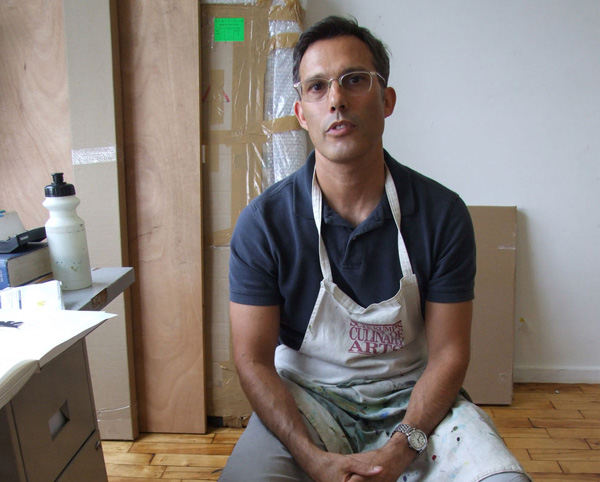
Steve DeFrank's new series of paintings in the exhibition Mirror, Mirror at Margaret Thatcher Projects plumb the depths of personal myth to reveal deceptively cheerful and malevolent emotions. His paintings depict a saccharine sweet caricatured naturalism rendering images of hidden sexual desire represented by images of degradation such as tree stumps and wooden boards riddled with carvings of phrases such as "Aunt Fancy" and "I Love Cum". The paintings are playful, but in a mischievous and subversive way and offer a significant departure for Defrank who had developed a signature body of work based on the format of the lite-brite toy. Steve and I had the opportunity to speak about his work shortly after the exhibition opened.
Andrew Cornell Robinson: You made a transition in your work. You moved away from your signature lite-brite compositions and created this incredibly series of paintings. Tell me about what was going on as you were going through this transition.
Steve DeFrank: I was doing the lite-brites, they were my gimmick, my shtick. It was beautiful, it gave me many gifts, and what I'd like to say is that my medicine finally kicked in.
ACR: You studied painting...
SD: I was trained as an academic painter. And that's what happened with the lite-brites. I studied at the Maryland Institute College of Art and then the School of Visual Arts.
ACR: I did too.
SD: You did not!
ACR: Did you have to draw those fucking plaster casts from the Parthenon at Maryland?
SD: Oh my god, yes!
ACR: When I was looking at your recent work I was struck by the attention to craft. And I don't mean that in a negative sense at all.
SD: I don't take it as that. In fact the lite-brites were doing the same thing. I was tinting my own lite-brite pins, and dotting those I's and crossing those T's. Craft is the same exact itch, it's just that the lite-brites became a gimmick, and there was no room left to grow after some time.
ACR: So you went through this radical change as an artist, and you did this in public. That must have been difficult. Think of all the flack that some one like Phillip Guston got when he made a radical shift from abstraction to painting objects and figures late in his life.
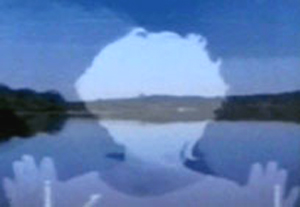
Who Do You Think You Are and What Do You Think These Little Films Can Do
Films By Mary Filippo
7:30pm Saturday 27 September 2008
Anthology Film Archives - 32 2nd Avenue, New York NY
$8
This Saturday at The Anthology Film Archives, filmmaker Mary Filippo presents an evening of short works that span some 20 years of creative output. Oftentimes personal, self-reflective and richly discursive, Filippo's work explores the formal periphery of documentary strategies while remaining firmly located on the self in relation to a troubled landscape of social and economic inequity. In The Trickle Down Theory of Sorrow for example, the filmmaker imagines herself in her mother's silhouette, reflecting on her own working class upbringing and later coming into middle class life and motherhood -- a transition mediated by a set of developing relationships to labor, consumption, gender and globalization. Also showing as part of Saturday's program will be an excerpt from the upcoming work How I Can Enjoy Mine When You Don't Have Any, a video on how contemporary undergraduate-level economics is taught in the United States. Visualizing abstract economic concepts through the use of classroom footage, interviews, news clippings and simple DIY animations, the filmmaker creates an unpretentious critique of some very rightist tendencies from a ground level view of financial and economics training -- frequently the formal and formative entry points of an entire managerial class. The filmmaker will be in person to introduce her work and lead a discussion with the audience following the screening.
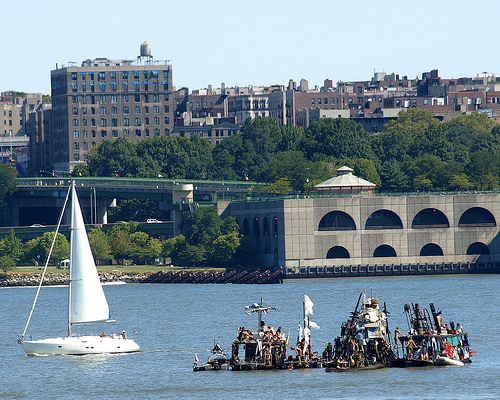
Swimming Cities of Switchback Sea
Deitch Projects, Long Island City - 4-40 44th Drive, Long Island City NY
7 September - 19 October 2008
Watching the seven boats of the Switchback Sea crew pull up at Deitch Studios was spectacular. We waited as a marching band played their punk rock take on songs of wayward ships and seafaring adventures. The impressive constructions were part of a flotilla of seven ships, each one hand made, impeccably decorated with sundry metal parts, junkyard salvaged goods, cardboard cut-outs and a massive dose of enthusiasm from its devoted crew. This first ship that pulled up was the steamboat, a beautiful vintage vessel intricately decorated and engineered by a skilled crew from San Franciso with a gassifyer that burns wood or coffee. Next came the rafts, each fantastically adorned with all salvaged parts, wheat pastes and screen prints, with a motley group of punk pirates who all contributed to the project and lived on the boats for two months.
The Swimming Cities of the Switchback Sea are exactly what the name suggests, veritable city-like vessels that float down the Hudson river as an art project that culminated at Deitch Studios with a play by Lisa D'Amour about the mysteries, whims and creations that a life at sea can reveal. This junkyard caravan carried the crew of artists, musicians, engineers, cooks and lucky groupies in a punk rock summer camp for older kids, mostly in their 20s and 30s, for a dream trip. So taken aback by the visual spectacle of the floticalla, some concerned citizen on the Staten Island Ferry allegedly called the police, thinking, perhaps not so erroneously, that the crew were pirates. There was even a baby on board who took his first step across one of the vessel's decks, walking on water in the most memorable of circumstances. Besides pirate planks, ferris-wheels, chairs, swings, appliances, resounding musical instruments, tattood skinny punk boys with extremely tight pants, feathers, and ornate costumes, Swoon's installation at the gallery was another deftly clever meander through a dark and undgeground city replete with its own characters. Her wheat-pasted, cut out portraits are giant; they loom atop sculptural formations made with discarded furniture, ropes, painted boards and doors and even a gilded corner replete with random items stacked, tied and assembled and then spray painted gold. Together with the seven vessels of the flotilla, Swoon has created a magical place that uses sculpture as a performance space, combining the installation and performance with an accessible platform for other artists to collaborate, musicians to play, playwrights to produce and spectators to watch and partake in the creation as it happens.
Swoon's floating art project might well be a direct descendant of the Miss Rockaway Armada rafts that sailed down the Mississippi river for the past two summers. The Miss Rockaway was largely an idealistic experiment in communal living where crew members dumpster dove for food, lived on the kindness of strangers in every city and town they would visit and made collective decisions on all matters concerning the journey. Each visited town became a carnival of music, artists, free silk-screening workshops, acrobats, dancers, and general festival-like celebrations of life through art. With no set goals of pre-planned destinations, the crew lived at sea for several months, changing and evolving across the way. Switchback Sea, however, was more explicitly an art project; enlisting the help of seventy-five plus volunteers, Swoon realized her vision with a visual cornucopia of crazy elements whose size and marks of craft bear the sign of a love's labor. The Miss Rockaway Armada is currently stationed at the Mass MoCA in North Adams, MA and will be there on view until March 19, 2009. While the future of the Swimming Cities is not confirmed, the crew may head to Venice next year. While these intrepid vessels may not be equipped to cross the Atlantic, perhaps the crew will develop a flying element, adding a whole other dimension to the scope and scale of the project.
Democracy in America: Convergence Center
21 September - 27 September 2008
Park Avenue Armory - 643 Park Avenue
Signaling an enthusiasm for a potentially historic November this year, Creative Time opened Democracy in America: Convergence Center yesterday at the Park Avenue Armory in Manhattan, a week-long exhibition and event program in the landmark city-owned building. A year in the making and one of Creative Time's single largest public art efforts, Democracy in America, curated by Nato Thompson, presents over forty different projects, including several specially commissioned for the exhibition and executed around the country. On the fourth floor of the Armory, for instance, Sharon Hayes presents an installation that features video and sound recordings from two different public performances the artist staged at both the Republican and Democratic National Conferences earlier this year. Using simple formal devices like collective recitation, repetition and a poetic compositional style that negotiates the historical, confessional and fictional, Hayes' new work is both an emotionally compelling aesthetic experience and strongly politically discursive. Also recommended in the exhibition is Carlos Motta's video installation on political consciousness in Latin America, Martha Rosler's collage take-away, Steve Powers' creepy animatronic waterboard simulation (recently commissioned by Creative Time as part of Democracy... and installed on the boardwalk in Coney Island), documentation from Mark Tribe's Port Huron project - also commissioned - in which historic New Left speeches from the 60s and 70s were publicly performed, Chris Sollars' personal documentary on George Bush's 2004 re-election, Angel Nevarez and Valerie Tevere Another Protest Song karaoke installation, and a selection of secret special forces non-identification patches collected by artist and writer Trevor Paglen.
Strongly recommended this week, as part of Democracy in America's event programming, is writer and theorist Brian Holmes' talk on Wednesday at 7pm at the Armory. Holmes is currently at work on Continental Drift, a project on geopolitics and geopoetics that is part text, part seminar in development with 16 Beaver.
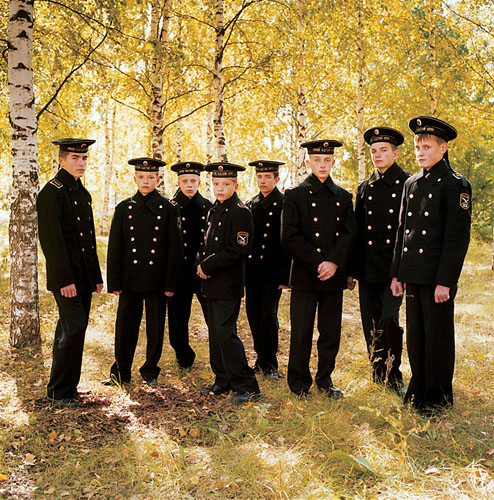
Men in uniform touch a deep nerve in Russia. The Soviet history of heavy internal policing has certainly left behind a symbolic residue on the personal dress code of state power. This sensitivity plays out across a spectrum of current shows in Chelsea that engage with soviet history and contemporary Russia.
Russia's appeal as a timely subject for contemporary art production is driven by more fundamental factors than the recent conflict in Georgia and its contested origins. Flush with black gold, Russia's rich can afford to outbid older money on the auction block; art dealers are clamoring to tap this lucrative market by introducing edgier contemporary art that evokes this country's past and future.
What unifies these different works together is the spirit of art as critique. Each work seeks to indict the culture that lends the uniform its menacing power.
A chilling portrait of young Russian cadets by Michal Chelbin is currently on view at the Andrea Meislin Gallery. Their unconfident and awkward poses betray their adolescence and insecurity. Looking tough involves much more than pursed lips and their eyes glaze over like a deer in headlights. The black uniforms contrast sharply with the aspen's amber leaves, white speckled trunks, and dancing patches of sunlight; it looks as if they are wearing black holes. This picture invokes an inherent insecurity for which many soldiers seek to compensate with their uniform.
New York: Past, Present, and Possible Future
3pm Saturday 20 September 2008
New Museum - 235 Bowery New York NY
$12
This Saturday afternoon at the New Museum, writer and editor Brian Sholis moderates a panel of temporal pluralities on New York - as both an imagined and surveyed site. Writer Matthew Sharpe will read from his 2007 novel Jamestown, featuring a post-apocalyptic New York in which Brooklyn and Manhattan are constantly at war with each other. Joining him on stage will be artist Matthew Coolidge, founder of the Center for Land Use Interpretation, who will discuss Up River: Points of Interest on the Hudson from the Battery to Troy - an installation on view this past spring at the PARC Foundation Gallery in New York. The installation features a large-scale topographic map of points of historical interest and more recent developments are represented with aerial photographs and text. Landscape ecologist and conservation planner and Eric Sanderson will also be speaking this Saturday on his Mannahatta Project, an effort to reconstruct the ecology of early 17th Century Manhattan when the island was first visited by explorer Henry Hudson.
Financial journalism, and economics since around the mid 17th century, has increasingly been about abstractions: intricate movements of people, money and material described and occasionally visualized, but remaining essentially invisible. They endure, like climate change and remote international conflicts, as that which might inspire excitement, worry, fear, or action - and yet necessarily demand a kind of belief in order to do so. Belief in the economy, as belief in anything else, becomes a certain emotional temperature that elevates a thing from an idea to a fact. It cannot be anything but this. So it may be with a sense of puzzled anxiety, an anxiety without an image or a face, that one reads in today's Times of the $85 billion Federal loan to save A.I.G., the capsizing international insurance giant. Equal puzzlement or slightly chastened awe, perhaps, might be inspired on the same day upon reading, on top of Artforum.com's news page, of Damien Hirst's potentially precedent-setting 2-day primary market auction sale, collecting for the artist $200.8 million in the sale of all but three of the 167 works to see the auction block. These numbers in their excess, of profits or deficits, seem to become less real with each shift in the order of magnitude, or move of the decimal point.
Tonight at at Location 1, a different kind of visualized excess occurs. Artist Jane Philbrock talks to Mass MoCA's Denise Markonish about PULL, an installation on view at the not-for-profit through 8 November. The installation is "comprised of 502 fire alarms, strobes, smoke detectors, siren horns, control panels - and one customized vintage fire pull station... Developed in collaboration with 18 engineers from Honeywell’s Fire Systems Group, PULL urges viewers to realize their hidden desire to sound the alarm, here in the form of an historic fire call box situated in the center of the gallery space. Once triggered, the work blossoms into a flourish of lights, words and deafening sirens — a wake up call." A wake up call maybe, although from what dream to what reality remains much less clear than the material extravagance of the piece.
Collector's Workshop, Introduction to Affordable Photography
Panel Discussion
6:30pm Tuesday 16 September 2008
Aperture Gallery - 547 West 27th St, 4 Fl, New York NY
Tomorrow evening Aperture Foundation hosts Collector's Workshop: Introduction to Affordable Photography, a panel discussion. Present to discuss will be Aperture's Kallie McLaughlin, Humble Art Foundation's Amani Olu, collector and blogger Ruben Natal-San Miguel, and Chicago-based artist Brian Ulrich. Laurel Ptak of I Heart Photograph will be moderating.
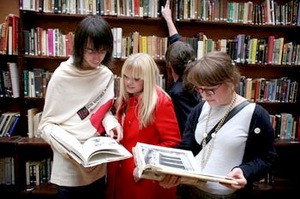
Martha Rosler Book Launch at Printed Matter
5-7pm Saturday 13 September 2008
Printed Matter - 195 Tenth Avenue, New York NY
Writing on The Martha Rosler Library in the 2007 essay If You Read Here..., curator Elena Filipovic begins with the following quote from Ralph Waldo Emerson:
A man's library is a kind of harem...
To what then, might the library of one of America's most important living artists - and, a woman! - be compared? Filipovic's opening provocation here is one of several in the short text, first appearing in the journal Afterall last year and now collected in a recently published book marking the Rosler Library's installation at Site Gallery in Liverpool and Stills. The attractive little book is full of color photo inserts and also features Paris-based theorist Stephen Wright interviewing Martha Rosler and artist Anton Vidokle - another of the project's primary catalysts. Printed Matter in Chelsea will be hosting a launch party tomorrow evening for this book as well as a second: a facsimile reprint of Rosler's postcard novella Service: A Trilogy on Colonization, originally published by the bookstore in 1978, long since out of print. Service... features three short stories that Rosler self-produced and non-commercially distributed via post in the 1970s, in fragments, before consolidating the bits into a book. The bilingual narrative of the text relates the experiences of immigrant laborers in the United States working for little money in service related industries, without the support infrastructure of citizenship or strong family networks. The work, composed while the Brooklyn-born artist was living in California, certainly reflects a kind of West Coast experience and likely - not to mention quite sadly - what seems to be a significant piece to the wider contemporary American experience.
R. Luke DuBois: Politics As Usual
September 12 – October 11, 2008
bitforms gallery, 529 West 20th Street, NYC
There ought to be a word to distinguish work like R. Luke DuBois' Hindsight is 20/20 series, from the more partisan, committed work that usually goes under the moniker, 'political.' Conceived as a procession of lexical snapshots, Dubois has arranged words from various State of the Union speeches in the format of eye-examination posters - here transformed into light boxes. The words appear in descending order of frequency, with the largest being those that appear most frequently in the speech's text. It is a concept that satisfies beyond its undeniable cleverness; both practically, as a fascinating visual distillation of political history, and metaphorically, as the each image begs the question of our access to it - prodding us to consider, quite literally, the degradation of our political senses. Hindsight... is included in the artist's solo show Politics as Usual opening tomorrow at bitforms gallery. There is an opening reception from 6:30-8:30, and an artist's talk at the gallery Saturday, October 11 at 4pm.
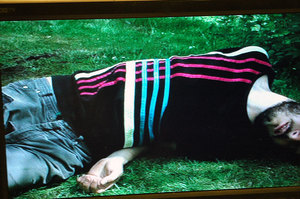
NADA Video Nights
7pm Wednesday 10 September 2008
NADA - 504 West 22nd Street, 3rd Floor
$3 suggested
NADA inaugurates their Fall screening series tonight with two programs from 7-9pm at their new 22nd St. location. The first will be a YouTube mixtape curated by artist Jeff Tranchell, while the second will be First Impressions, a program curated to Lumi Tan to "to ease the transition from a lazy summer to an anxious fall." Anticipate work by Harrell Fletcher, Owen Land, Jennifer Sullivan, Matthew Lutz-Kinoy and others. Popcorn and Grolsch beer will be served, and Astroturf will be installed in the screening space - together offering, perhaps, a bit of late summer simulacrum. Consequently, visitors are encouraged to tote along lawn chairs or blankets to the event.
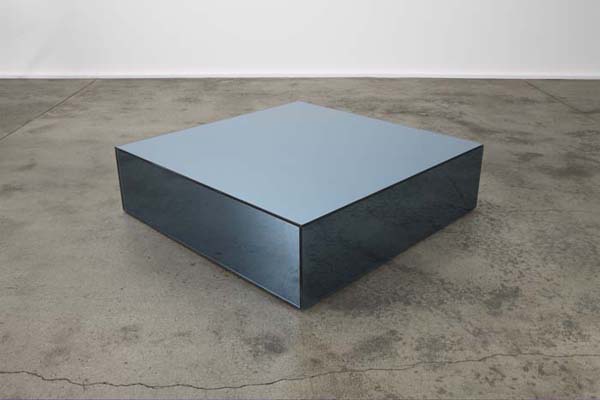
Quiet Politics
Zwirner & Wirth - 32 East 69th Street, New York NY
26 June - 29 August 2008
If "doing something poetic can become political, and sometimes doing something political can become poetic," then what is left of each position following said becoming? This is the question at the heart of Quiet Politics, a group exhibition recently closed at Zwirner & Wirth's uptown location. What is left of the political when it has become poetic and vice-versa, and further, if there isn't a more tenacious opposition at work here than indicated. Does the political, if it is worthy of that name, necessarily eclipse the poetic? Indeed Quiet Politics seems bent on pushing this question to the limit by presenting a collection of works that move from the loudly political to the obliquely so, if at all.
Thus David Hammons' U.N.I.A. - an American flag done up in the colors of the Pan-African flag - doesn't seem quiet at all, never mind silent. If anything it is its poeticism that is relegated to a hushed whisper, a sort of formal sarcasm and nothing more. Similarly, Micheal Brown's literally ham-fisted broken mirror/shattered glass routine In The Meantime... lands like a slogan shouted against mimetic subtlety in favor of a classically Brechtian didacticism. Fortunately, both pieces inhabit the front room, providing both a transition from the clumsily branded pageant of the Upper East Side and juxtaposition with the quieter work in the back.
Katy Siegel: Millions of Artists, and all pretty good...
6:30pm Tuesday 9 September 2008
SVA - 133/141 West 21 Street, room 101C
In the short essay The City in the Age of Touristic Reproduction, Boris Groys theorizes the emergence of the global city as a step away from the radical modern formalism of 20th century Utopian projects towards a new ideal: important cities that resemble one another not by a forfeit of local specificities but rather by their systemic reproduction and dissemination. That we may enjoy ethnic cuisine with slight variations far from the places of their historical origin is one such development Groys cites in which "far from becoming extinct, local features have in fact become global." There is a resemblance between these global urban centers without prototype or relative features of origin. The germ of these similarities may be located in the practices now common to these places: the aggressive export of local culture, freighted by mushrooming networks of electronic communication technologies and the sophistication of contemporary transport engineering.
Cultural producers, Groys goes on to suggest, are equally subject to the globalization of cultural flows, often compelled towards frequent international travel in pursuit of the facilitating institutional and economic support networks that make ambitious cultural work possible. Philosopher Steven Lukes, last week in conversation with Slavoj Žižek in New York, joked that the two of them were members of a worldwide "frequent flyers club" - a fact necessitated by the heights of their critical engagement and the dispersed support structures for such work. The kind of internationalization that propels these modes of working and travel habits equally rewards artists and intellectuals who position and market themselves as international brands.
Tomorrow evening at the School of Visual Arts, critic Katy Siegel kicks off the Fall lecture series with a talk on a slightly narrower purview of the patterns Groys describes: the globalization of the playing fields of contemporary art, and its effect on emerging and would-be art producers. From the press release:
As contemporary art increasingly becomes a global business and producers are growing in number, artists in training compete not only with peers from other BFA and MFA programs, but with artists around the world. Siegel’s talk examines how this “crowd scene” affects the individual artist. Katy Siegel is an associate professor of art history at Hunter College, a contributing editor to Artforum and an acclaimed curator.
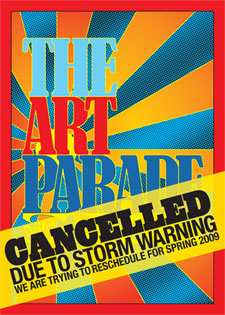
Art Parade - Canceled
Fashion Week with Ayah Bdeir
Saturday, September 6, 2008 4pm Free
Eyebeam - 540 W. 21st St.
Deitch Projects' Art Parade has been canceled due to a severe storm warning. Instead, head down to Eyebeam for a fashion-week inspired performance by Ayah Bdeir. Bdeir will hold a runway show of her and Luma Shihab-Eldin's Syrian-style technologically hacked lingerie on the street in front of Eyebeam, where she is currently a fellow. Having grown up between Lebanon, Canada, and the US, Bdier recruits technology to investigate (and indict) kitsch orientalism, and popular representations of the middle east. Her work has included "interactive installations, electronic fashion, gadgets, [and] reactive furniture." The performance on offer tomorrow appears to detour the post-feminist profiteering that is the sexy-undies industry in a sly critique of the high-minded, if sometimes oblique, patronizing of Islamic women by their more liberated western counterparts.
OUT NOW!
Opens 6-8pm Friday 5 September 2008
e-flux - 41 Essex St, New York NY
The Brooklyn Rail Silent Art Auction
6-9pm Thursday and Friday, 4 and 5 September 2008
Pace Wildenstein - 534 W 25 St, New York NY
Tomorrow night e-flux opens OUT NOW!, a group exhibition and event program at their new Essex Street location. Organized by Anton Vidokle, OUT NOW is a timely gesture towards the upcoming presidential elections and the ongoing public debate about the legacy of the current administration and a war that is at once the name of a ruined state and perhaps the single most defining issue of American international affairs in the past five and a half years. Comprising a small international group of artists, writers and activists, OUT NOW takes an unapologetically direct thematic approach to politics -- an uncommon decision, perhaps, in a cultural terrain where irony and formal hermeticism enjoy a much stronger currency over political earnestness and openly discursive art making.
Meanwhile in Chelsea, The Brooklyn Rail hosts the second day of their two-day Fifth Annual Fundraiser at Pace Wildenstein (the first day of which is tonight, from 6-9pm). The impressive roster of artists who have donated work -- which will be on view from noon to 6pm, and auctioned off from 6-9pm -- is available on the benefit web site.
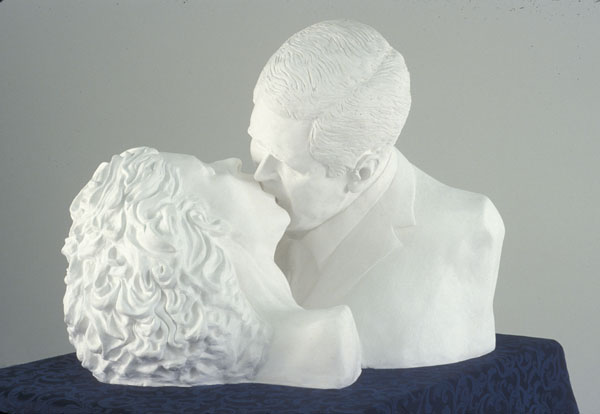
It's the first week of September, when most of the art world wakes from its collective stupor to offer a slew of new openings. And, being an election year, the press releases resound with politics -- the War, the Market, the Race -- with everyone from this year's pile of wits, activists and mandarins looking to add their two cents. Featuring several different takes on things to come -- from moods of veiled optimism, to more cautious, seasoned approaches -- here are ten shows that provide an engaging start to the political season.
Creative Time is throwing its own version of a national convention with Convergence Center, filling the massive Park Avenue Armory with performances, installations and artworks. Among the myriad spectacles -- wandering surveillance balloons and a "functional replica of America's first submarine" -- there's a laundry list of political theorists, artists and activists scheduled to give talks tackling a range of issues from "city politics...to cultural production." Downtown, artists are embracing the market. The latest iteration of Phoebe Washburn's fascinating, crude factories (see the Gatorade-fueled nursery she furnished for this year's Whitney Biennial) is at Zach Feuer in Tickle the Shitstem. A vision in plywood, the eponymous Shitstem manufactures "beverages, pencils, colored urchins and t-shirts" endlessly -- until it breaks. Kevin Bewersdorf's shamanistic take on corporate culture will be on full view when his website-slash-corporate identity, Maximum Sorrow, plasters V&A with brochures, posters and videos in Monuments to the INFOspirit. Taking a more meditative approach to labor and production, Amanda Coogan will scrub a wide, sun-colored dress for hours at a time in her Sisyphean performance Yellow at Artists Space.
Several exhibitions are looking backwards for instruction -- a line-up of shows gives photographic renditions of some of the 20th century's most notable conflicts. Susan Meiselas' retrospective In History will exhibit the stark work she completed following the Sandinistas in Nicaragua and, later, her coverage of the Kurdish uprisings -- providing a framework to ask incisive questions about the use of photojournalism in war. An admittedly more wistful take on the possibilities of revolution, Burt Glinn's Havana remembers a peach-faced Castro and a fawning populace at the end of the Cuban revolution (the gray afterglow of Castro's reign or the messy politics of a Ché t-shirt should a provide good counterpoint to the show's sheeny idealism). Of the three, it's Josef Koudelka's Invasion: Prague '68 that may prove the most prescient of the bunch; his feverish series of large-scale photos capture Russia's invasion of Prague nearly 40 years ago, bringing swiftly to mind the superpower's recent military intervention in South Ossetia. In a more contemporary vein, stalwart Martha Rosler updates these references with her photomontages that splice vignettes of the Iraq War with haute-couture spreads in Great Power" at Mitchell, Innes & Nash.
A more indirect, puckish appraisal of American politics is available too. While Allison Schulnik's goopy avatars of clowns appear garish and kitsch, it's her unsparing and exacting use of paint that betrays a tragic reading of culture in No Luck Too at Mike Weiss. The monomaniacal Agathe Snow follows up on her previous projects (an eschatology of New York, a week-long dance marathon) with Just Say Yes, an all-over installation at James Fuentes. From the artist's statement--an effusive rant on Leonardo DaVinci and the American Dream -- to the lines of at-attention ladders in the work, Just Say Yes provides a welcome buoyancy, wallowing in primary colors and the possibilities of a wide-open gallery.
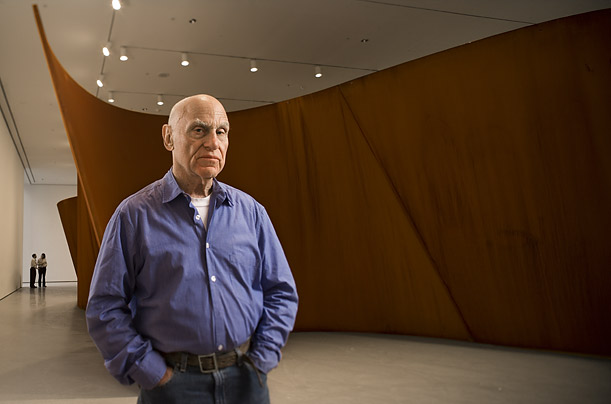
Richard Serra: Thinking on Your Feet
Directed By Maria Anna Tappeiner, 94 minutes
Through 2 September 2008
Film Forum - 209 W Houston St, New York NY
Editor's note: Richard Serra: Thinking on Your Feet is currently showing at Film Forum, New York, through 2 September 2008. Tonight's 8pm showtime will be introduced by Jane Panetta, curatorial assistant in the Department of the Chief Curator at Large at MoMA.
Tomorrow morning we will be publishing a previews feature for the week on occasion of the opening of most of the city's galleries for the Fall art season.
We should all applaud Maria Anna Tappeiner for realizing a film on Richard Serra that reaches for themes beyond the Titled Arc. Retelling that story of ostensible government censorship and an artist clamoring for his right to expression is beating a dead horse. Tappeiner digs deeper and has forever enriched the Serra archive by presenting a vivid glimpse into the personality behind these important works.
The opening scene depicts the artist wandering through his sculpture park at the Bilbao Guggenheim. His crumpled linen sports jacket, simple blue jeans, and butch stride reveal his salt of the earth persona. He speaks about how his undulating slabs of steel create voids. In a style reminiscent of Hitchcock giving you clues about a film you haven't yet watched, he throws in your face that you don't get his work or jargon yet. But it makes you want to grasp it by the end of the film.
Action then shifts to the German factory that fabricates Serra's imposing steel slabs. There is something Pharaonic about watching all these men toil away to create these massive 21 ton metal creations. Much like a pyramid, these works draw energy from the elaborate technical undertaking and sheer manpower of their creation.
ZINE
HOME
TIPS / COMMENTS
CATEGORIES
CONTRIBUTORS
- Greg Afinogenov
- B. Blagojevic
- Adda Birnir
- Susannah Edelbaum
- Julie Fishkin
- Paddy Johnson
- Jessica Loudis
- Christopher Reiger
- Andrew Robinson
- Peter J. Russo
- Blythe Sheldon
- S.C.Squibb
- Hrag Vartanian

